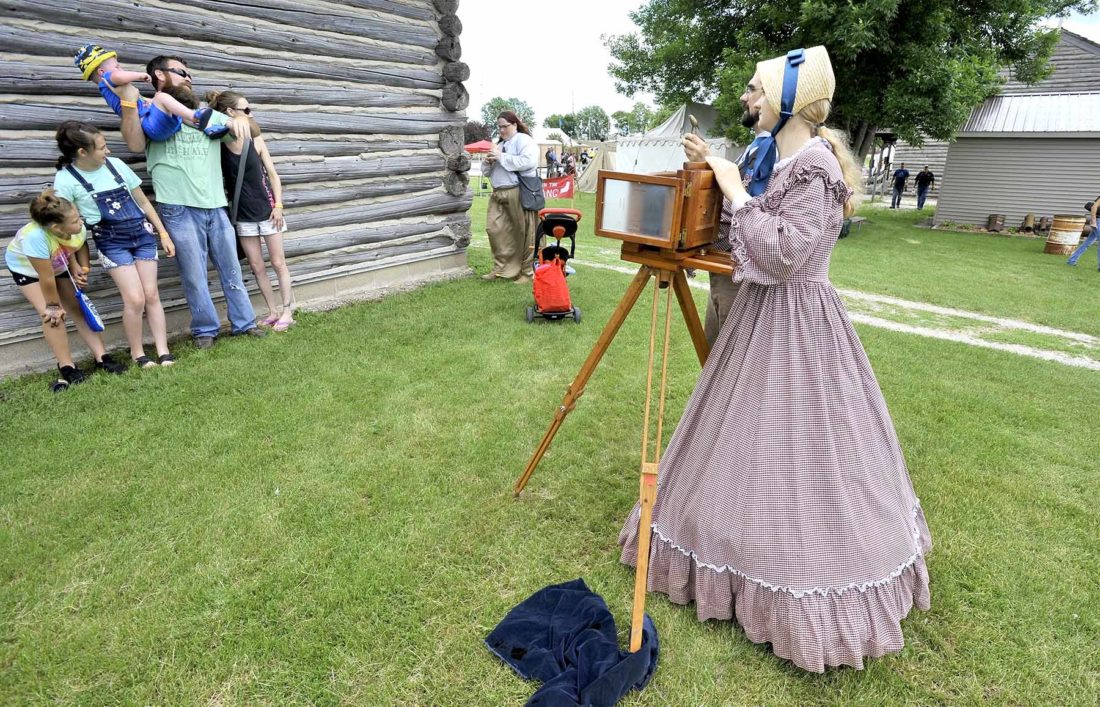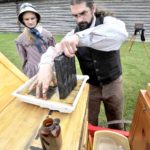Yep, the past is back
Tin photos. Trick roping. Harsh medicine. Victorious shootouts.
-
-Messenger photo by Hans Madsen
Chris Olsen, of Aurora, Illinois, makes noises with his 1880s-era photographer’s birdie as his daughter, Louisa May Olsen, 15, uses her hand as a shutter during a 3-second tintype exposure Saturday afternoon at the Original Wild West Frontier Days at the Fort Museum and Pioneer Village.
-
-Messenger photo by Hans Madsen
Jim “Wild Jim” McBee, of Prairie du Chien, Wisconsin, fires a shot in defense of the bank’s box of money as he and his fellow Hole In The Sock Gang members entertain the crowd at the Original Wild West Frontier Days at the Fort Museum and Pioneer Village Saturday.
-
-Messenger photo by Hans Madsen
Louisa May Olsen, 15, of Aurora, Illinois, uses her hand as a shutter during a three-second tintype exposure of Marty “The Oklahoma Kid” Tipton. Tipton was performing and demonstrating his roping tricks and decided to have a tintype made.
-
-Messenger photo by Hans Madsen
Chris Olsen, of Aurora, Illinois, finishes developing a wet plate photograph as his daughter, Louisa May Olsen, 15, keeps an eye on the process.
-
-Messenger photo by Hans Madsen
John Bonner, of Vincent, whose character is a frontier-era doctor, shows off his book of formulas.
-
-Messenger photo by Hans Madsen
Haylee Scott, 8, of Fort Dodge, works on a rope trick Saturday afternoon under the watchful eye of Marty “The Oklahoma Kid” Tipton.
-
-Messenger photo by Hans Madsen
Chris Olsen, along with his daughter, Louisa May Olsen, prepare to make a three-second tintype exposure. From left, Harlow Fox, 9, of Woolstock; Ryleigh McFarland, 11, of Lehigh; Jake McFarland and Brittany Harris, of Webster City, pose. Dax McFarland, 1, wanted no part in the “hold still” and ended up being a blur in the finished photograph.
-
-Messenger photo by Hans Madsen
Chris Olsen works under cover of darkness to sensitize a plate for making a tintype photograph Saturday at the Original Wild West Frontier Days at the Fort Museum and Pioneer Village.

-Messenger photo by Hans Madsen
Chris Olsen, of Aurora, Illinois, makes noises with his 1880s-era photographer’s birdie as his daughter, Louisa May Olsen, 15, uses her hand as a shutter during a 3-second tintype exposure Saturday afternoon at the Original Wild West Frontier Days at the Fort Museum and Pioneer Village.
A few visitors to the Original Wild West Frontier Days at the Fort Museum and Frontier Village Saturday had the opportunity to stand stock still for a few seconds.
Why stand stock still? Because if they didn’t they would become a blur on the wet plate photographs being made by Chris Olsen, of Aurora, Illinois, who was demonstrating making tintypes with his daughter, Louisa May Olsen, 15, who, yes, is named after the author.
The elder Olsen got his start when he purchased a machine that coats metals onto glass. His original use for that had been making telescope mirrors.
Turns out, the same machine was also useful for making Daguerreotype plates.
The toxicity of some of the materials involved led him to wet plates instead.

-Messenger photo by Hans Madsen
Jim “Wild Jim” McBee, of Prairie du Chien, Wisconsin, fires a shot in defense of the bank’s box of money as he and his fellow Hole In The Sock Gang members entertain the crowd at the Original Wild West Frontier Days at the Fort Museum and Pioneer Village Saturday.
“Elemental iodine, bromide and mercury are not the friendliest materials to work with,” he said.
Wet plates are also a lot less time-consuming — relatively.
“It takes hours for a Daguerreotype,” he said. “Wet plate is eight minutes start to finish.”
He coats the plates with an emulsion he creates himself — just like it was done in the 1850s when the process was invented.
“You take a glass or metal plate and pour collodion on it,” he said. “That’s a mix of ether, nitrocellulose and a couple of natural salts.”

-Messenger photo by Hans Madsen
Louisa May Olsen, 15, of Aurora, Illinois, uses her hand as a shutter during a three-second tintype exposure of Marty “The Oklahoma Kid” Tipton. Tipton was performing and demonstrating his roping tricks and decided to have a tintype made.
“To make that light-sensitive, you put it in a silver nitrate bath,” he said.
He uses a camera that’s a replica of one from the era that’s fitted with a vintage lens. The camera has a hand shutter — the users hand is used to uncover the front to the required exposure, measured in seconds, then used to block the light when the exposure is done.
A light-proof plate is used to protect the sensitized plate from fogging It’s pulled out of the camera just prior to making the exposure and put back in when it’s done.
So how sensitive are the plates?
“They have an ISO between .8 and 1,” he said. “Daguerreotypes are even slower. They’re .003 ISO.”

-Messenger photo by Hans Madsen
Chris Olsen, of Aurora, Illinois, finishes developing a wet plate photograph as his daughter, Louisa May Olsen, 15, keeps an eye on the process.
A modern digital camera will usually set itself to an ISO of 100 or 200 in bright sunlight.
Yes, there’s a cloth to peer under to focus and Olsen also has an antique 1880s-era brass “birdie” that makes chirping noises.
Tintypes were a popular recording media from the time of their introduction. They were used by Civil War-era photographers and troops who would have their photographs taken.
Many of those images still survive.
Louisa May Olsen has been helping her father since she was 7, she said.

-Messenger photo by Hans Madsen
John Bonner, of Vincent, whose character is a frontier-era doctor, shows off his book of formulas.
“It’s a lot of fun.”
She’s expecting him to make her senior pictures in a few years, with a vintage process.
The wet plate process fell out of vogue when commercially made dry plates became available in 1875.
“The last wet plate photographer of the old school worked until 1945 in Arizona,” Chris Olsen said.
He uses the process to photograph anything and everything one would use a modern digital or even a film camera for, including a classic “figure study.”

-Messenger photo by Hans Madsen
Haylee Scott, 8, of Fort Dodge, works on a rope trick Saturday afternoon under the watchful eye of Marty “The Oklahoma Kid” Tipton.
“I did one nude with it,” he said. “Unfortunately, it was a middle-aged man.”
Working with the chemicals has an very visible side effect.
“This is from the silver nitrate,” he said holding up his stained hands. “It’s the black finger fraternity.”
•
Frontier Days also offered another connection to the past. Mark “The Oklahoma Kid” Tipton can trace his skills and talents back a few years.
“I’m a fourth-generation trick roper,” he said. “From the Will Rogers family.”
Tipton was giving demonstrations of his skills Saturday and also teaching anyone who wanted to learn some basics.
Teaching tricks is also part of his professional life.
“I’m the only one teaching,” he said.
He is also unique in that, like Will Rogers, Tipton entertains the crowd with jokes and banter while he’s doing the tricks.
Haylee Scott, 8, of Fort Dodge, seemed to have taken an interest in rope tricks. She stayed behind working on one.
“It wasn’t that hard,” she said.
•
For those who got sick in the frontier era, the doctors of the time could offer them little except pain killers, laxatives containing mercury, and one or two fewer limbs.
John Bonner, of Vincent, was on hand Saturday to show off the medical practices and instruments of the time.
On a table were several examples of high cringe-factor instruments.
“The amputations,” he said pointing out a tool that resembles a modern hacksaw.
His character joined the U.S. Army in 1861 as a commissioned captain on the Union side. Before that, he was under contract.
Surprisingly, one of a doctor’s most important roles on campaign had nothing to do with medicine.
“We did surgery, pharmacy and dentistry,” he said. “We also tracked the weather. That was one of the most important jobs.”
•
Jim “Wild Jim” McBee, of Prairie du Chien, Wisconsin, survived a shootout in the middle of the street Saturday. He emerged without a scratch, but with several empty guns and the bad guys who tried to rob the bank’s money box littering the street and playing dead.
For the Hole In The Sock Gang, Old West shootouts are what they do, and do well.
McBee joined the group about eight years ago when his brother was making a documentary film and needed extras. Once in period costume, the rest was, well, history.
And a few bruises.
“I bounced on the ground 20 times that day.”

-Messenger photo by Hans Madsen
Chris Olsen, along with his daughter, Louisa May Olsen, prepare to make a three-second tintype exposure. From left, Harlow Fox, 9, of Woolstock; Ryleigh McFarland, 11, of Lehigh; Jake McFarland and Brittany Harris, of Webster City, pose. Dax McFarland, 1, wanted no part in the “hold still” and ended up being a blur in the finished photograph.

-Messenger photo by Hans Madsen
Chris Olsen works under cover of darkness to sensitize a plate for making a tintype photograph Saturday at the Original Wild West Frontier Days at the Fort Museum and Pioneer Village.











